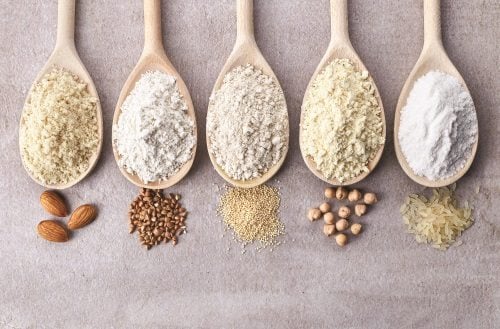Applications for Ohio Farm Bureau Health Plans now available
Members have three ways to apply: contacting a certified agent, calling 833-468-4280 or visiting ohiofarmbureauhealthplans.org.
Read MoreWhile walking down the baked foods aisle at your local grocery, you’ve probably noticed an abundance of gluten-free products taking over store shelves. The trend leads many to wonder: is there something wrong with eating foods containing gluten?
Gluten-free foods are produced to help those with gluten sensitivity or those with celiac disease, a genetic autoimmune disorder where the ingestion of gluten leads to damage in the small intestine.
According to information from Ohio State University’s Chow Line newsletter: “Gluten is a protein that occurs naturally in wheat, rye, barley and hybrids of those grains. Although oats do not contain gluten, they can be contaminated during harvest or processing with grains that do, so people with celiac disease usually avoid oats, as well.”
Gluten-free products are featured predominantly in baked goods such as bagels, muffins, baking mixes, breads, pretzels, crackers, rolls, buns, cookies and wafers. However, according to Ohio State, other foods that contain gluten aren’t so obvious, including candies, gravies, salad dressings, sauces, seasoned rice mixes, flavored snack foods, soups and soup bases, vegetables in sauce and processed lunchmeat. This is why labels are so important.

“Gluten-free” products replace the proteins found in wheat, barley and rye with many different types of substitutes in order to provide a product that is safe for those with celiac disease or gluten allergies,” according to registered dietician Lisa Andrews.
Andrews said celiac disease affects only 1 percent of the U.S. population, yet gluten-free products have become a part of nearly every large food companies’ portfolio, grabbing 6 percent of the total baked goods market share in the United States last year, according to PR Newswire’s Gluten-Free Food and Beverages Market Report 2016-2026.
Grain farmers like Ron Burns are always adapting their cropping plans to meet consumer demand, and determining the gluten-free trend’s impact on wheat demand is unclear. “Most of the time the commodity markets don’t react to such small changes in food sectors, and as a farmer that sells directly to the elevator on contracts, I focus mostly on that for my crop (planting) decisions. Markets like organic wheat are really what I’m keeping my eye on and raising specialty wheat for.”

Diana Baker, business development manager at food ingredient company Budenheim, works to develop alternative gluten-free ingredients for food products. Baker, a Madison County Farm Bureau member, said there are trade offs, though.
“They never are quite the same product when there isn’t gluten anymore though,” she said. “Substitutes must be found for the structure that gluten provides.”
Baker works with food companies across the United States to help them find viable substitutes for ingredients or to perfect their baking recipes.
Baker’s work combined with farmers’ ability to grow crops for a variety of markets illustrates the farm and food community’s ability to provide products to meet specific needs. This large variety of products is one of the reasons the simple act of grocery shopping can be so confusing, especially when it comes to food labels. When a label indicates a product is “free” of something, shoppers are left to wonder what the implied benefits are.
Andrews cautions that going gluten free isn’t necessarily the best option if the goal is losing weight. “Gluten-free diets can sometimes help those other autoimmune diseases like rheumatoid arthritis or type 1 diabetes,” she said. “But many people think that going gluten free will help them lose weight, which usually isn’t the case and it is important to be aware of how to replace that fiber in your diet…Brown rice, pasta, potatoes and quinoa are all good substitutes for the fiber in wheat, barley and rye.”



Members have three ways to apply: contacting a certified agent, calling 833-468-4280 or visiting ohiofarmbureauhealthplans.org.
Read More

Bill Patterson, Cy Prettyman and Adele Flynn will continue to serve as officers for Ohio Farm Bureau Federation.
Read More

Delegates discussed many topics impacting agriculture including farmland preservation, local foods, and succession planning.
Read More

Twenty-six farmers govern the state’s largest farm and food organization.
Read More

The 2025 recipients are Fred Cooke (posthumous) of Richland County, Marvin Dietsch of Williams County, Steven Knollman of Hamilton County and Michele Miller (posthumous) of Ottawa County.
Read More

Nathan and Jill Parriman grow seasonal crops, including Christmas trees, pumpkins and cut flowers, providing U-cut experiences that invite customers to engage directly with agriculture.
Read More

The 2025 Distinguished Service Award recipients are Craig Adams, Mike Townsley, and Kellogg Farms, Kurt Farms and Stateler Family Farms.
Read More

Ohio Farm Bureau Treasurer Adele Flynn participated in the meeting, representing Ohio farmers.
Read More

For Ohio and PJM region, the outlook is reassuring—ample reserves and strong planning should keep the power on.
Read More

The average price for a classic holiday feast for 10 in Ohio will cost $55.87.
Read More